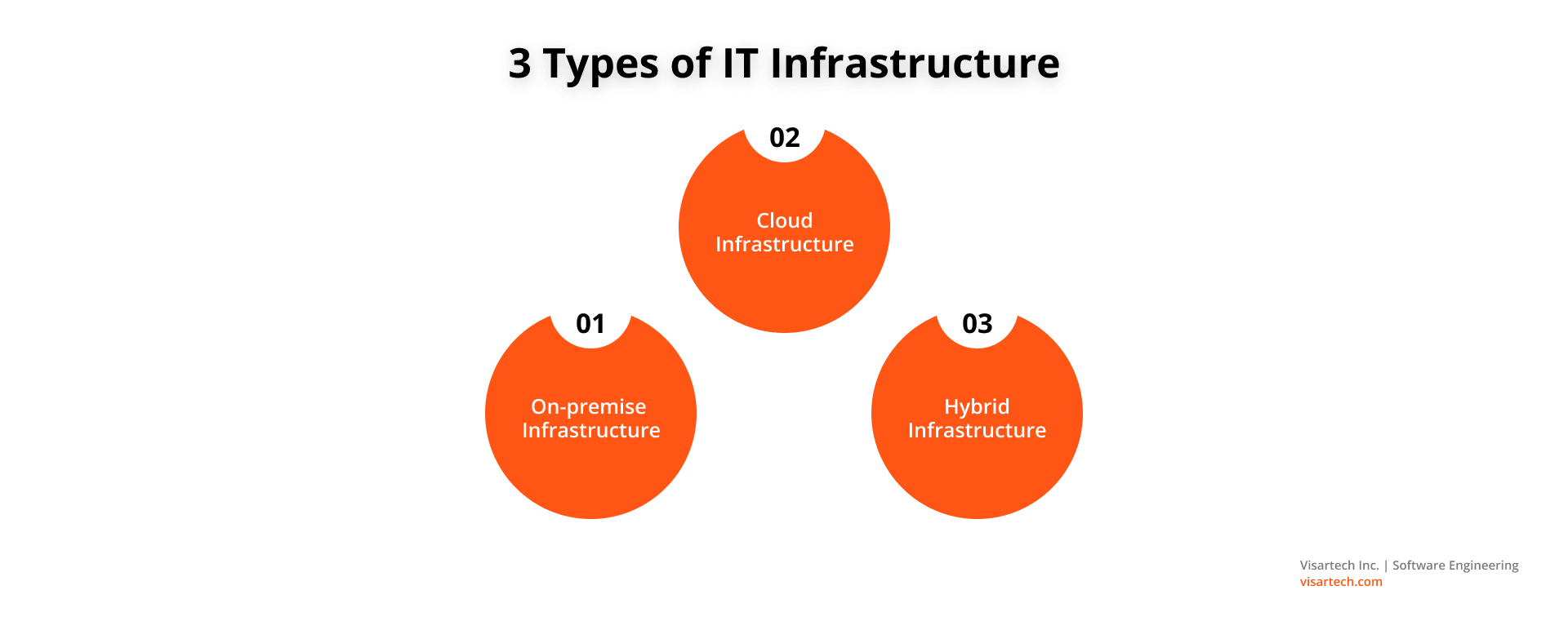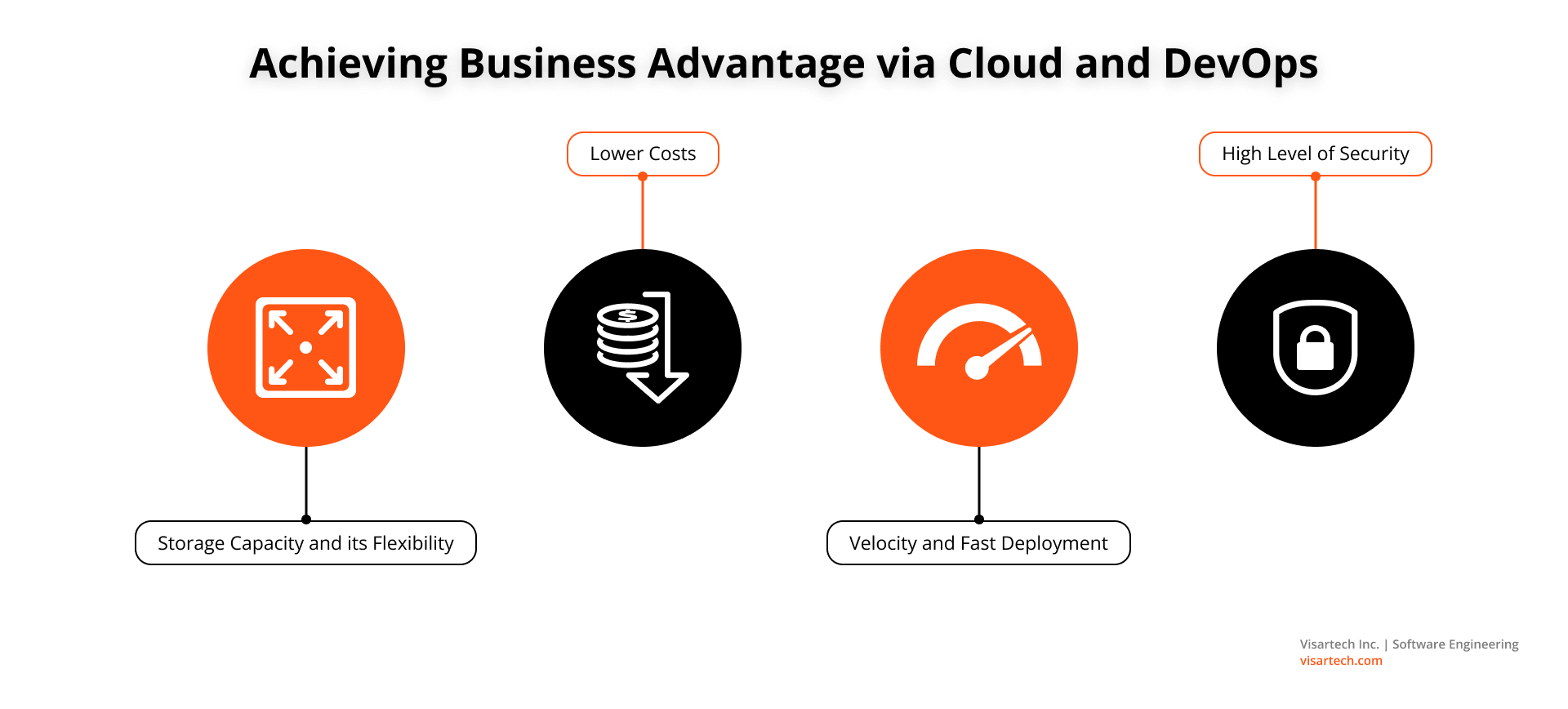Optimizing IT infrastructure is a crucial aspect of modern business operations. A well-configured IT infrastructure can enhance productivity, reduce downtime, and increase customer satisfaction.
“By fine-tuning your business operations and IT infrastructure, you can ensure that your business runs smoothly and delivers top value to your customers.” Slava Podmurnyi, shared on Forbes
However, many businesses struggle to optimize their IT infrastructure due to management and security oversights, outdated devices, and data management issues. These can lead to decreased productivity and disgruntled teams. Moreover, optimizing IT infrastructure can be a costly and complex process, leaving businesses unsure of where to invest their resources.
At Visartech, we understand the challenges of optimizing IT infrastructure, and we are here to share expertise. In this article, we will explore how DevOps and cloud can streamline your IT infrastructure and help your business stay competitive in the digital age.
3 Types of IT Infrastructure
An adaptive, reliable, and secure business IT infrastructure gives your organization a competitive edge in the marketplace. If an IT infrastructure of an organization is poorly arranged, connectivity, performance, and security challenges for enterprises, including system outages and breaches, are possible. The effectiveness of your company’s infrastructure may ultimately determine whether it is profitable or not.
There are three well-known types of IT infrastructure that support core business objectives. They have enhanced staff productivity, exceptional customer service, the prompt introduction of new solutions, and data gathered in real-time for fast and informative business choices.
#1. On-premise Infrastructure
A traditional type of technological infrastructure. It consists of standard hardware and software elements and is often established on-premise (for both private and business-specific use).
However, such configuration often demands more resources compared to other forms of IT infrastructure. Specifically, the amount of free space at the deployment site and the equipment’s own power. On-premise infrastructure must thus be developed and installed at higher costs.
#2. Cloud Infrastructure
A cloud computing option is very similar to the traditional type of IT infrastructure. But there are a few important differences that make the cloud the most beneficial option for business. Namely, end users may access the infrastructure practically anywhere the internet connection is possible and from any device using virtualization.
No wonder this type is the most preferred choice by businesses. Because of its flexibility, you may manage the internal company infrastructure without spending money on hardware and data centers.
#3. Hybrid Infrastructure
This type of infrastructure is simple. It’s the combination of on-premise data centers as well as private and public clouds. Your company’s needs dictate where the operating systems will be carried out within a hybrid environment.
Firms may use the hybrid type to capitalize on the flexibility of a public cloud and the security of a private cloud. This architecture is considerably more adaptable than a conventional type, enabling you to customize the cloud solutions to meet your unique requirements.
However, due to the presence of two distinct IT environments, the hybrid infrastructure’s biggest disadvantage is the increased management complexity. Additionally, it may be more expensive.
Read also: Digital Twin Development Benefits and Costs
Learn ways digital twin technology can update your businesses
These days, businesses prefer cost-cutting strategies, which makes a cloud IT infrastructure their top choice. With this kind of architecture, companies may rent data storage from cloud computing service providers rather than shelling out cash for owning internal physical servers. Higher scalability and infrastructure automation are two additional benefits that cloud computing can provide.
What Are the Benefits of DevOps and Cloud Working Together?
If your company aims to hit the sweet spot between digital transformation, IT infrastructure cost optimization, and market recognition, cloud adoption is an absolute necessity. DevOps, in turn, fosters teamwork through increased productivity, smaller development lifecycles, and shortened time-to-market. When these two operations are combined, the cloud development methodology undergoes a sea change.
The on-premises infrastructure usually has excess resources to handle peak loads. By fully exploiting the benefits of cloud computing, DevOps can truly make a difference. So, if you choose to automate vital steps in business infrastructure optimization, you only use and pay for the assets you require.
Such a combo can turn into a practical cost-saving measure for your team. Other pros of mixing the cloud capacity and DevOps best practices up include:
Storage Capacity and its Flexibility
Cloud service providers can give limitless processing, network, and storage space for customer data. With its enormous scalability and flexibility, cloud computing allows organizations to store their data in a distant place that is accessible from any computer or device without sacrificing data management. This helps them deploy apps in various countries and regions of the world, reduce storage expenses, and free up space on internal servers.
Read more: Trunk Based Development in Continuous Integration
Discover the benefits of being in real-time sync
Because they can quickly add more resources, the cloud helps DevOps teams develop new procedures and enhance the ones they already have. Enterprises must take into account embracing technologies like cloud services to build a dynamic DevOps environment.
Lower Costs
The cloud reduces business costs associated with purchasing hardware and software, setting up and maintaining data centers, procuring servers in bulk, professional assistance, and other services. Having a thorough DevOps strategy in place allows a company to dramatically reduce expenses while also boosting profitability.
Companies using data on a variable basis should consider the cloud. Though, regardless of the size of their budget, nobody wants a nasty surprise regarding the cost of company infrastructure optimization. DevOps teams offer the extra benefit of cloud infrastructure cost optimization by focusing on resource consumption first.
For a better understanding of how exactly cloud computing can reduce IT infrastructure budgets, we will share the details of our project. Working on the Metaverse for Remote Collaboration, our Visartech team chose the right Amazon EC2 (Amazon Elastic Compute Cloud) type which, in turn, reduced the production environment costs by 80%. More specifically, we conducted the load tests that allowed us to find the minimum requirements for the required load. We also have created a solution to get rid of extra spending on the environment during the inactive time. At the request of the admin user from the administrator console, the remote collaboration environment can be stopped or started.
Velocity and Fast Deployment
One of the greatest benefits of combining cloud and DevOps is enhanced productivity. Enterprises may expedite their development procedures by integrating the two. This results in projects being completed faster and with fewer errors. Furthermore, more frequent solution releases improve the quality of the final product by enabling the prompt fix of any flaws and the introduction of a new feature.
As a result, your company’s resources will be used more efficiently, and you’ll be able to deliver products and services to the market rapidly in today’s business environment. This way, businesses may shorten the time it takes to develop new solutions by automating processes and leveraging the synergy of the cloud and DevOps.
High Level of Security
High-security standards are a critical problem for both DevOps and the cloud. The process doesn’t end after architecting and implementing the necessary security controls. DevOps teams must constantly monitor their cloud infrastructures to keep security in check. They can set alerts for any configuration changes (e.g., changes in security groups or unauthorized access).
The agile DevOps process incorporates security into the solution through proactive security audits and security testing. Detecting any critical areas in the development pipeline is another important aspect of DevOps infrastructure optimization, particularly when it comes to security measures.
DevOps teams must adhere to security best practices to provide solutions that their clients depend on. In case any vulnerability arises, they monitor, manage, and reduce security risks.
According to Gartner, by 2028, more than 50% of enterprises will use industry cloud platforms to fully implement their digital goals. Using cloud technology and DevOps services, businesses now have access to limitless benefits and solutions at a pace that works best for them. That is the unlimited functionality, simple and quick optimization, and agile IT environment.
When DevOps and the cloud work together, they build on each other’s advantages to provide an even more appealing product or service. DevOps teams are using the cloud to streamline their tech stacks. The cloud offers resources for centralized deployments and has the potential to enable DevOps right out of the box. The construction and architecture of clouds, in turn, enable them to fully utilize all DevOps techniques.
Top Challenges of Optimizing Cloud and On-Premise Infrastructures
Renovating your current network is a crucial part of updating your IT infrastructure. Basically, it’s all about creating a new data center, which gives the users access to a cutting-edge tech environment.
Business infrastructure optimization is considered the major method for increasing its capabilities by upgrading outdated or failing IT assets. However, optimizing different infrastructure types requires a nuanced approach, since there are a few challenges along the way, such as:
- On-premise optimization
The most difficult work in on-premise optimization (i.e., without moving apps to the cloud) is a thorough examination. In other words, on-premise. To solve this problem, you must have a clear picture of how your product or service users behave, when peak demand occurs, and the effort required to meet such demand. Besides, it makes sense to think of future solution development.
- Cloud optimization
Due to the uniqueness of cloud infrastructure, its optimization presents certain difficulties. Let’s say we have a system with an operational process developed seven years ago. The team is unaware of any potential effects from process optimization because, in most cases, the creators of this process are no longer involved in this project. Here, IT infrastructure optimization carries a danger of systemic failure.
Technologies Used for IT Cloud Optimization
A competent service in IT starts with a well-organized technology infrastructure. The latter is closely intertwined with rising cloud adoption. However, the growing demand for cloud computing might strain your corporate resources and operational technologies.
Organizations now have many options for developing state-of-the-art solutions thanks to the spread of cloud computing services. But if your company can’t optimize infrastructure, it cannot fully take advantage of the cloud’s promise.
As a solution, leading cloud providers offer many tools and IT optimization services, which you can use to optimize your business. By using IT infrastructure technologies, you get access to qualified experts who work together with your internal IT team. They carry out independent audits of the cloud infrastructure. This way, you can better comprehend how it functions, the possibility for improvement, and discover possible cost optimization strategies.
Amazon Web Services (AWS)
An expert cloud provider streamlines the core operations of your business and drives growth. AWS cloud solutions are well-suited for companies that require rigorous standards for compliance and security. Using this framework, you may see what architectural methods are optimal for developing and managing high-performing systems on the Amazon cloud.
Businesses choose to utilize AWS to construct their apps because of the richness of services it provides. AWS cloud technology is the ideal solution for tech teams due to its manifold capacities. They include analytics, management, IoT, databases, security, and corporate apps.
Azure
Azure now has a slightly higher adoption rate (80%) among businesses, compared to AWS’s 77%. Plus, due to Microsoft’s established partnership with the industry, Azure provides a range of services for businesses, thus becoming a preferred option for modern users. Organizations may equip their teams with corporate software solutions and take use of cloud computing by using this tool.
Adopting this cloud-optimizing technology can upgrade the operation of the entire platform for firms relying significantly on the Microsoft ecosystem. Azure Kubernetes is a service offered by Microsoft Azure, along with hybrid cloud solutions.
Google Cloud Platform (GCP)
The world’s greatest search engine in history makes the Google Cloud Platform a unique tool in the market. Its internal research and competence are nearly limitless. GCP stands out because of its contribution to the creation of several open-source technologies. Startups and mature businesses that embrace Google Cloud technology can benefit from its innovative culture.
The Google Cloud Platform provides suggestions, preferred methods, and practical guidance. It assists cloud experts in the design and governance of safe, robust, high-performing, and profitable cloud infrastructure. Also, GCP is the best bet for organizations that use cutting-edge machine learning and artificial intelligence (AI) technology.
Other Options
Salesforce is another tool used for cloud infrastructure optimization. It evaluates how your company uses the CRM, where you are gaining from it, and where you are having problems. As an alternative option, you can opt for a set of optimization software solutions called IBM Decision Optimization. This technology offers prescriptive analytics to assist your company and tech team in making better decisions and achieving outstanding business results.
Cloud computing, however, is more than just technology. It’s about teams of passionate techies whose productivity is directly linked with how good IT infrastructure is developed and updated. Cloud optimization aims to cut down on resource waste by selecting, configuring, and optimizing resources for specific applications.
Most of the companies use AWS, Azure, and Google Cloud as the basic technologies to optimize IT Infrastructure. But still, the experienced solution providers are not limited to a single set of tools to deliver flexibility and innovation. Depending on the existing state of the IT infrastructure and the specifics of the company, they expand and modify this set.
How To Drive A Successful IT Infrastructure Optimization Process?
IT infrastructure optimization consists of three basic steps, regardless of your choice of optimization strategy. They are planning, auditing, and implementing. Let’s examine these phases in more detail.
#1. Audit
An essential step in IT infrastructure management. You may anticipate and fix any system flaws by performing a technical audit, and you can also understand the possible effects of infrastructure optimization. At the audit stage, the team needs to find strong justifications for why optimization is necessary and its potential side effects. Also, the long-term performance of updated infrastructure must be considered.
- On-premise audit
Knowing your infrastructure system is fundamental to efficient on-premise infrastructure audits. You must be aware of the amount of memory your system uses, the number of machines in your data center, and the amount of memory your system has.
- Cloud audit
For a cloud audit, you need to know your company’s resources and how they are utilized. If you keep your data on-site or in the cloud, it’s important to recruit a capable DevOps team to perform a thorough assessment of your current network.
#2. Plan
When you are done with the audit part, it is time to move on to the planning phase if the infrastructure optimization needs to be carried out. Your team chooses the optimization strategy that will work best for your company at this time. Planning becomes even more imperative as there are several options for updating the IT infrastructure of an organization:
- On-premise optimization plan
Given a simple architecture of this type, there are two principal strategies to optimize on-premise infrastructure – reducing the number of machines and memory size.
- Cloud optimization plan
Making Kubernetes clusters (or Docker containers) is a potential alternative for streamlining cloud networks. This strategy reduces hosting IT infrastructure costs and there won’t be any issues if a computer malfunctions. Hence, the system immediately switches over services housed on a failing computer to other ones. But if the computer returns to the system, the services likewise go back to where they were.
#3. Implement
A team moves on to the IT infrastructure implementation stage once they have distinct knowledge of how the optimization process will play out.
- On-premise implementation
Everything is fairly simple with this kind of infrastructure optimization. A data center’s machine count is typically reduced by professionals in the event of on-premise optimization.
- Cloud implementation
Meanwhile, it takes six key steps to implement cloud infrastructure optimization. They include:
- Re-hosting is the first and the simplest since it involves the least amount of time and coding.
- Re-platforming necessitates some more landscape improvements.
- A related strategy is modernizing, except certain application elements are improved or altered either prior to or after the infrastructure migration.
- The deconstruction of monolithic applications into microservices is a difficult process of rewriting.
- In case of a low ROI for migrating a traditional app to the cloud, the recommended course of action is to drop and shop.
- The final step, retaining, is a passive strategy since no migration is required. Applications are maintained in their exact form.
Read more: How To Build A Cloud-Based SaaS Application
Your comprehensive adviser to creating cloud-based SaaS applications
To sum up, your tech team must choose which strategy will help your optimization project the best and carefully consider how it should be put into practice. When it’s clear that business technology infrastructure has to be updated, the development team should become involved.
Wrapping It All Up
In 2022, 94% of enterprises have already switched to cloud computing in order to optimize their IT infrastructure. This is largely due to the decreased maintenance, security, and dependability expenses associated with migrating technological infrastructure to the cloud.
However, updating your IT infrastructure is a critical step to ensure your network functions in the most beneficial way for your business. Only then it can provide users with a more consolidated platform for corporate development and competitive advantage over rivals. As we can see, it’s best to combine DevOps best practices with cloud benefits to reach the ideal with infrastructure optimization.








